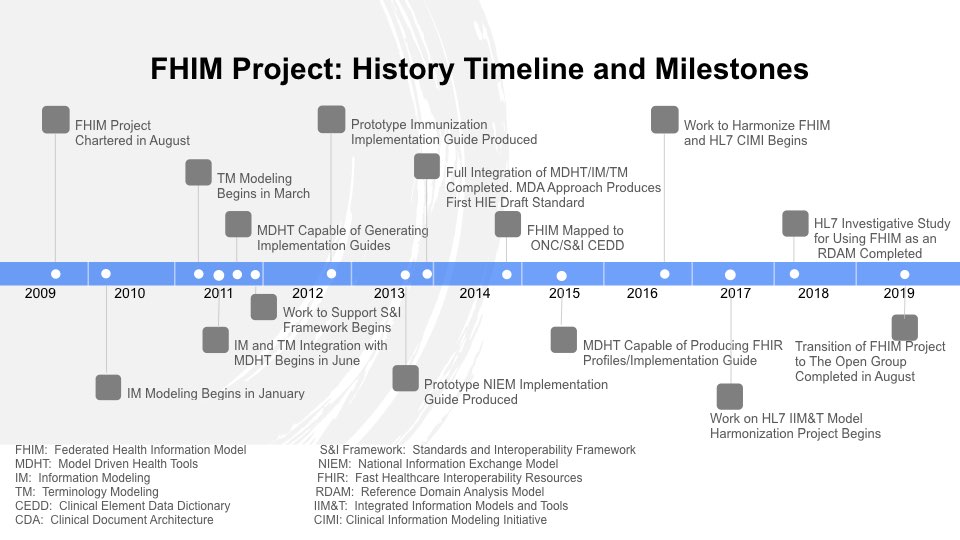The FHIM Project was established in June 2009 by the Federal Health Architecture (FHA) Office. The FHIM Project was transitioned from the FHA Office to The Open Group in September 2019. Below is a timeline of significant milestones for the FHIM Project followed by a brief history.

The original intention was to develop an information model as part of a federated enterprise architecture, which is reflected in the FHIM Project charter. Governance consisted of a steering committee of five federal partners and a workgroup that provided guidance on the day-to-day activities of the project. Initially the project consisted of one full-time FHA resource supported by in-kind resources from the federal partners. In 2011, the full-time resource was converted to part-time and money was added to the contract to hire three additional part-time resources to lead work related to information modeling, terminology modeling and implementation. In 2012, two additional part-time resources were added, an informaticist to support the terminology modeling work and an additional resource to support the information modeling work. The maximum level of resources on the project never exceeded 2.5 FTE.
A strategy document was developed in 2010 to guide the work of the FHIM Project. The primary goal of the project was to develop a comprehensive, integrated set of standards that fully support health information interoperability, including semantic interoperability. Achieving this goal required work in five strategic areas:
- Information Modeling - to address consistency and provide the basis for information interchange
- Terminology Modeling - to produce semantically consistent and interoperable content
- A Security/Trust Framework - to facilitate secure interchange among stakeholders and business partners
- An Information Exchange Framework - to support implementation and use of common exchange formats for messages, documents, and services
- A Common Standards Development and Implementation Methodology – to support collaboration, coordination and harmonization among SDOs in developing the models and frameworks cited above.
In January 2010, information modeling of the FHIM started; terminology modeling in support of, and integrated with, information modeling started in March 2011; and implementation work (in support of the information exchange framework strategic area), which leveraged an open source application called Model Driven Health Tools (MDHT), started in late 2011. Also in late 2011, a prototype project demonstrated the ability of the FHIM Project to generate CDA implementation guides, and work to support the National Information Exchange Model (NIEM) program was begun.
Also in 2011, work was begun to support the Office of the National Coordinator (ONC), including the Meaningful Use regulations and the Standards and Interoperability (S&I) Framework program. A significant amount of work was devoted to this effort, including a separate ONC contract with the FHIM Project to investigate how the project could be used in support of the S&I Framework.
In 2013, the three major work streams of the FHIM Project - information modeling, terminology modeling, and implementation - were fully integrated and a draft information exchange implementation standard was produced using a model driven architecture (MDA) approach. Also in 2013, a prototype NIEM implementation guide was produced.
In 2014, the FHIM was mapped to the ONC Clinical Element Data Dictionary (CEDD) and the following year to the CEDD successor, the Common Core Data Set (CCDS). The FHIM has continued mapping to ONC data requirements as they evolved over the years, including the latest set, the US Core Data for Interoperability (USCDI).
In 2015, the FHIM Project added support for the Health Level 7 (HL7) Fast Healthcare Interoperability Resources (FHIR) standard. The implementation work stream demonstrated the ability to generate FHIR profiles and implementation guides from FHIM content.
In 2016, work was begun to harmonize the FHIM and HL7 Clinical Information Modeling Initiative (CIMI). This harmonization work was expanded to include harmonization of other modeling efforts under an HL7 project, called Integration of Information Models and Tools (IIM&T).
In 2017, a significant amount of work was accomplished in support of the HL7 IIM&T project, including a two-day meeting of all the participants to plan future activities.
In 2018, an HL7 investigative study was completed to fully define how the FHIM could be leveraged as a Reference Domain Analysis Model (RDAM) to harmonize all the individual HL7 project and work group related domain analysis models. Also, further work was completed to support ONC programs, including Trusted Exchange Framework and Common Agreement (TEFCA) and USCDI.
In 2019, a number of training videos were produced describing the three work streams of the FHIM Project and how to access project information and a master presentation slide deck was produced drawing on slides from previous presentations over the years. Transition of the FHIM Project from FHA to The Open Group was started in March 2019. During the transition process, a new FHIM Profile Builder (FPB) work stream was initiated to develop user friendly software to access FHIM content and generate information exchange formats such as CDA, FHIR Profiles, etc. A demonstration version of the software was completed and used to produce a FHIR profile for immunization information. The transition of the FHIM Project from FHA to The Open Group standards organization was completed in 2019.
